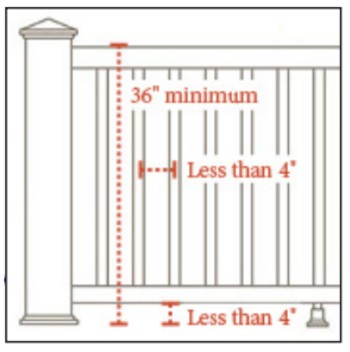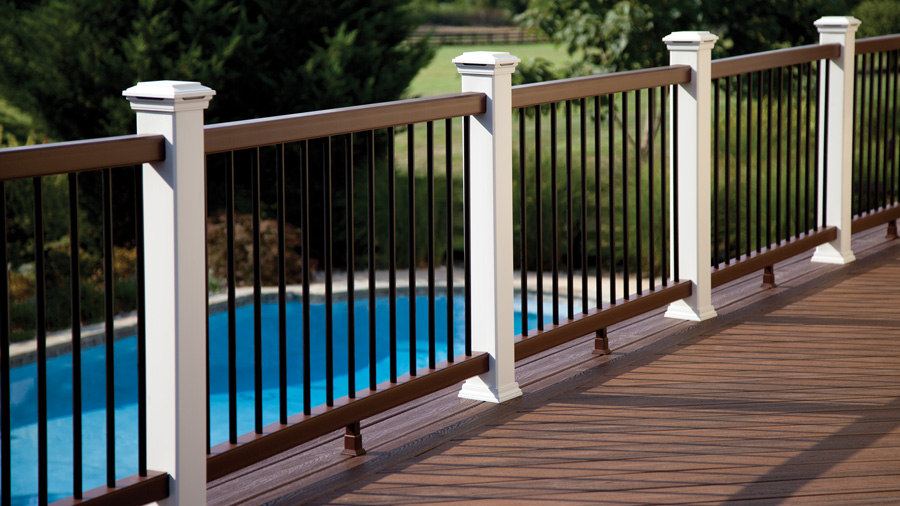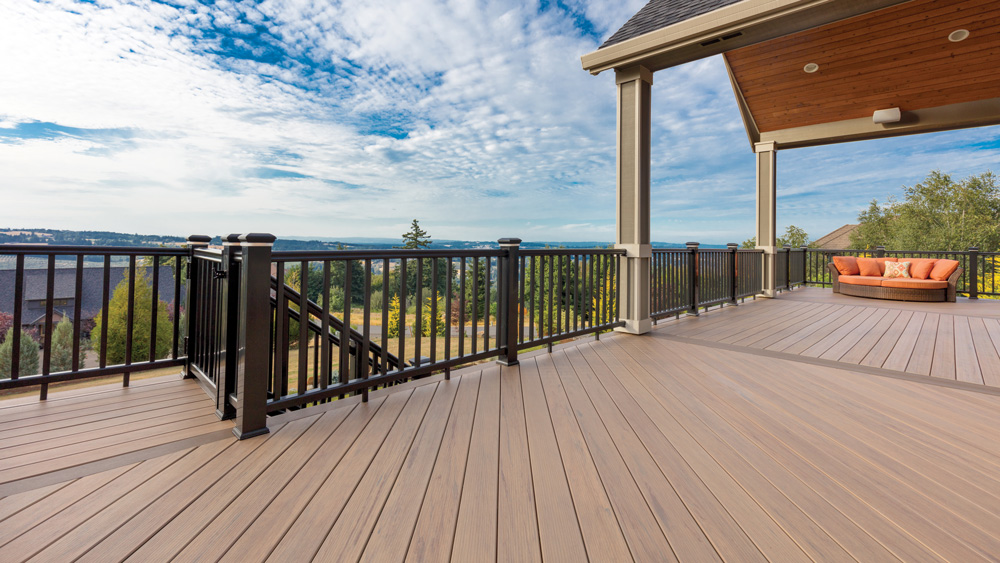How Do You Fix Loose Posts and Rails on a Deck?
Decks, porches, and patios are amazing home features - but a loose, wobbly railing can keep you from fully enjoying them.
Fortunately, there are some easy DIY steps to help you learn how to fix a loose outdoor railing. Whether you've got a creaky wood railing or a loose metal railing, DecksDirect is here to help you get your railing back in tip-top shape so you and your family can safely enjoy your deck space.
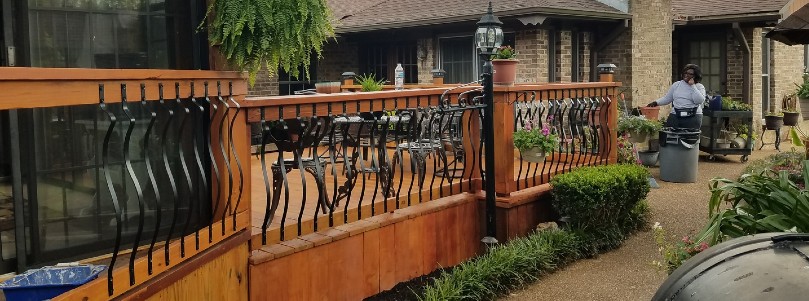
Identify the Causes of Loose Railings
Beyond being a nuisance and an eyesore, a loose deck railing is also a safety hazard. Before you learn how to fix a loose outdoor railing, it's important to figure out why the railing is unstable in the first place. Identifying the root cause will help you choose the right fix and prevent the issue from coming back.
Material-Specific Issues
Different railing materials deteriorate in different ways. Wood railings are prone to rot, splitting, and warping, especially if they haven't been properly sealed or are exposed to heavy moisture over time. Metal railings, while durable, can develop rust that weakens fasteners and connection points. If left untreated, corrosion can spread, making the railing wobbly. Composite railings, while resistant to rot and rust, can suffer from internal weakening due to improper installation or fastener failure, leading to loose connections.
Environmental Factors
Deck railings are constantly exposed to the elements, and that takes a toll. Moisture and humidity cause wood to swell and shrink, loosening screws and bolts over time. Wind and repeated stress (like people leaning on the railing) can slowly pull fasteners out of place. In colder climates, freeze-thaw cycles can expand cracks in wood or push fasteners loose, while salt air in coastal regions accelerates rusting on metal railings.
Loose or Failing Fasteners
A common culprit behind wobbly railings is loose or deteriorated fasteners. Screws, bolts, and brackets can loosen over time due to natural movement, vibrations from foot traffic, or improper installation. If a railing post wasn't secured correctly to the deck framing, it's more likely to become unstable.
Structural Weakness in the Deck
Sometimes, the issue isn't the railing itself, but what it's attached to. If the deck framing, rim joist, or post bases are weakened due to rot, insect damage, or general wear, the railing won't have a solid foundation to stay secure. This is especially common with older decks that haven't been regularly maintained.
By pinpointing what's causing the problem—whether it's loose hardware, weather-related damage, or structural issues—you'll be in a much better position to make long-lasting repairs.
How to Repair a Loose Wood Deck Railing
Here are some simple deck railing repair tips to follow if you have a loose wood deck railing:
1. Tighten any loose bolts or screws.
If your wood deck railing feels wobbly when you push or pull against it, it's likely a railing post to deck frame connection that's loosened. Posts should be fastened to the deck joists and beams with solid lag screws or bolts and surrounded with secure blocking.
Check each bolt and lag tightening with your power drill or ratchet to ensure each piece is fully driven. Do this to every post on your deck area that feels slightly movable. This will prevent any accident later on in the season and prevent you from having to make a second round.
2. Mount extra blocking between rim joists.
Installing extra blocking in a zig-zag pattern between the perimeter joists of your deck can help make your deck's rim joist stiff and unmoving. Doing so will increase the strength of the rail attachment and prevent your joists from bouncing over time.
3. Remove and replace any loose post-to-rail hardware.
If your deck railing posts feel sturdy, but the wooden rails between them can move, you'll want to inspect the screws, nails, or connectors used. More often than not, you'll see that metal hardware has corroded over time or loosened from its initial position. If your wood rails check out okay, we suggest removing the connecting hardware and replacing it with a newer piece.
While toenailing your top and bottom rails in place is often the easiest and cheapest option, today builders recommend against it. It can lead to more issues with wear and water-damage to your posts over time, which then leads to just replacing them. Keep your costs low and your deck rails securely in place for decades to come with steel or nylon Post and Rail Connectors.
4. Remove and replace any rails with signs of bowing, warping, or rot.
Sometimes, the issue of a wobbly deck railing isn't the fault of posts or hardware, but rather the wood deck rails themselves. If you see any notable damage on your rails, the best course of action is to switch out the rail with a replacement piece of lumber.
If rot or damage has happened to a lot of your wood railing, perhaps it's time to switch over to a new railing system altogether. Choose from options such as metal railing, vinyl deck railing, cable systems, and more to find the style that best fits the style of your outdoor space.
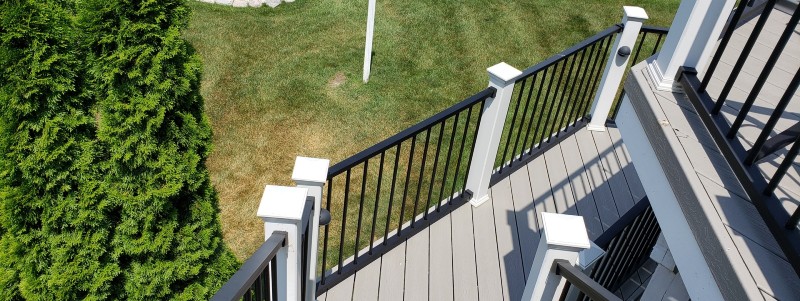
How to Repair a Wobbly Metal Railing
Here are some straightforward deck railing repair tips to help fix a wobbly metal railing:
1. Remove any rust from the loose railing.
After many years of exposure to wind, rain, and direct sunlight, even the toughest metal railings can grow a bit loose. Start by cleaning off any rusted spots on the railing, especially railing connectors and screws, with some simple white vinegar and a clean rag.
Finding rust in a few spots doesn’t mean that the entire railing has to be replaced, but it does need to be cleared away to prevent the railing hardware from loosening further.
2. Tighten any loose post-mounting hardware.
At each deck railing post, inspect the anchoring screws or bolts in the base plate. Check for firmness, and if they're feeling weak, use a power drill or ratchet to tighten the screws into the pilot holes. Drive fasteners in until fully set into the joists or blocking.
3. Replace any broken or worn post connectors.
If any of the structural screws or bolts anchoring your metal deck posts break or have grooves that are dulling, replace them. While just one fastening connector may not seem like a big deal, the added stress on the other anchors can cause breakage to happen in no time.
For standard pressure-treated decks, hardwood decking, and more, we recommend using the contractor's favorite GRK Rugged Structural Screws in a 4-inch length or longer. For mounting on concrete or stone patios, we recommend using the Caliburn XL Concrete Screws.
4. Inspect post-to-rail brackets for damage.
Very rarely, there may be an issue with one of the four mounting brackets in a railing section. This can cause the railing section to feel loose to any pressure. Check for any breakage or unfulfilled connections in the mounting brackets and either correct or replace the piece as needed.
5. Protect post hardware in the future with post skirts.
Attaching two-piece post skirts, or post base covers, to the bottom of your installed posts will prevent future problems. Post base trim will shield your structural screws from the daily grind of water, dirt, wind, and sun exposure and keep post hardware healthy for longer. Adding skirts or covers to your metal railings can prevent a loose railing before it happens.
When to Seek Professional Help
Knowing how to repair deck railing is one thing; knowing if you should is another. Some deck railing fixes are simple DIY jobs—tightening screws, replacing fasteners, or reinforcing a wobbly post. But in some cases, a loose railing is a sign of a deeper structural issue that requires professional expertise. If you encounter any of the following scenarios, it's best to call in a deck specialist or contractor.
1. Significant Structural Damage
If the railing isn't just loose but pulling away from the deck, the problem might be with the framing itself. Rotted rim joists, deteriorated post bases, or weakened connections can make the entire deck unstable. A professional can assess whether the structure is still sound or if larger repairs—or even a deck replacement—are necessary.
2. Fasteners Won't Hold
When screws or bolts keep loosening even after being tightened, it's a sign that the wood or material they're secured to has lost its integrity. Stripped screw holes, rusted-out brackets, or split posts may require more advanced repair techniques, such as inserting wood plugs, replacing sections of the deck, or using specialized fasteners.
3. Code Compliance Concerns
Deck railings must meet local building codes for height, post spacing, and strength to ensure safety. If you're unsure whether your railing repairs will be up to code—especially for multi-level decks or rental properties—a professional can ensure your deck meets all necessary regulations and passes inspection.
4. Complex Railing Systems
Not all railings are straightforward to repair. Glass panel railings, cable railings, and certain composite or aluminum systems often require specific hardware and installation techniques that may not be DIY-friendly. If your railing has unique connectors, tensioning systems, or hidden fasteners, hiring a pro can save time and prevent costly mistakes.
5. The Railing Moves Excessively
If tightening fasteners and reinforcing posts don't stop the railing from swaying or feeling unstable, the underlying issue might not be fixable with basic adjustments. Excessive movement can indicate a design flaw, incorrect post installation, or a fundamental weakness in the deck's support structure—all of which should be assessed by an expert.
Fixing a loose railing can be a quick weekend project, but knowing when to call in a professional can save money, time, and potential safety risks. If you suspect structural issues, need help with a complex railing system, or want peace of mind that your repairs are up to code, an experienced contractor can ensure your deck is as safe and secure as possible.
Frequently Asked Questions
As a leader in the $4.1 billion North American deck market, DecksDirect has a wealth of knowledge to share. Here are some common questions we receive./p>
Can I use wood glue or epoxy to fix a loose deck railing?
Wood glue or epoxy can help reinforce minor cracks or splits in wooden railings, but they won't provide enough strength to secure a wobbly post or loosened fasteners. For long-term stability, it's best to use through-bolts, brackets, or additional blocking to properly secure the railing.
Can I fix a loose railing without removing it completely?
It depends on the cause of the looseness. If the issue is simply loose screws or bolts, you can tighten them without removing the railing. However, if the railing is unstable due to rot, rust, or structural failure, taking it apart may be necessary to properly reinforce the connections or replace damaged components.
What's the best way to prevent my railing from loosening again?
Regular maintenance is key. Check fasteners and tighten bolts at least once a year, reseal wood railings to prevent moisture damage, and inspect for rust on metal components. If your railing is in a high-traffic area or exposed to heavy weather, consider upgrading fasteners to more durable options, like stainless steel bolts or structural brackets.
Knowledge Center
Tips and tricks on deck building and designing from the experts here at DecksDirect!


